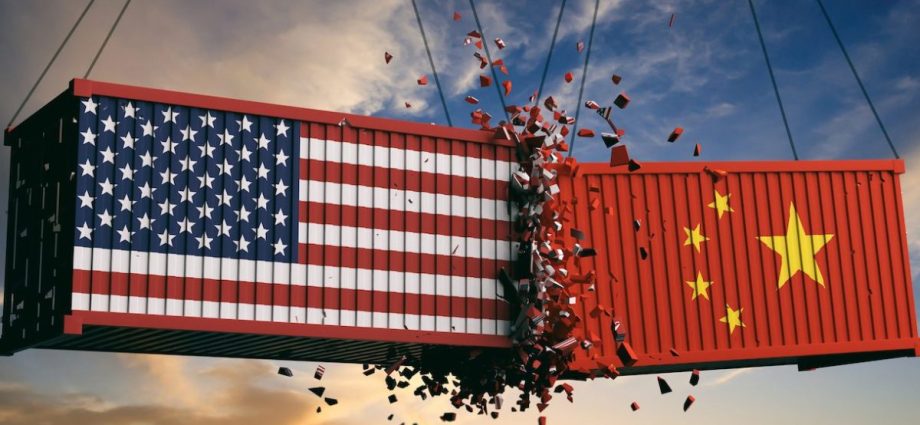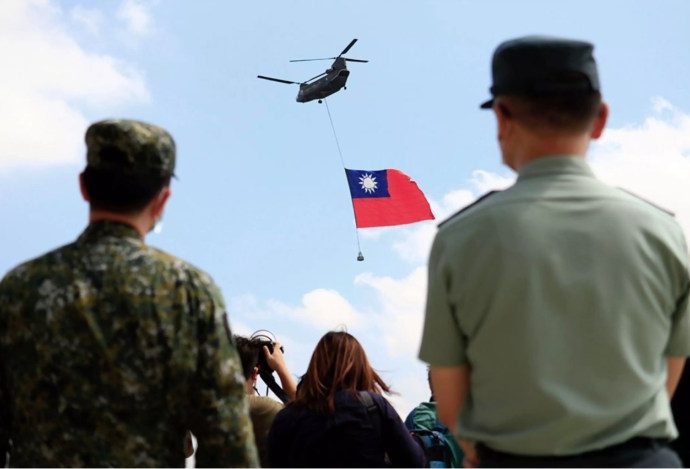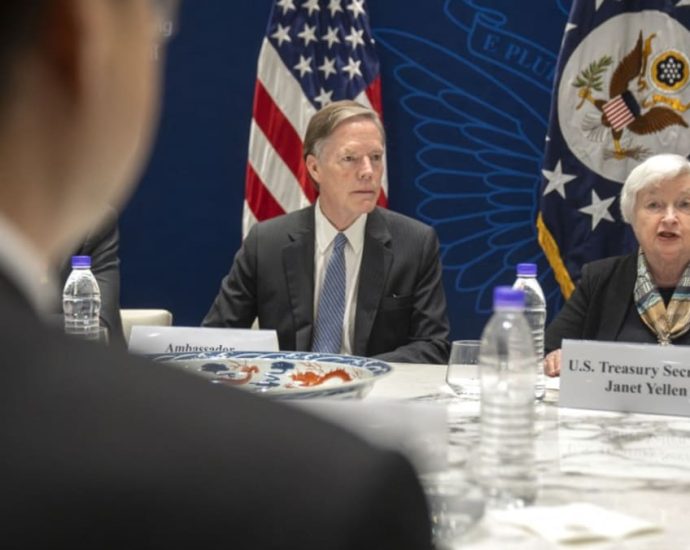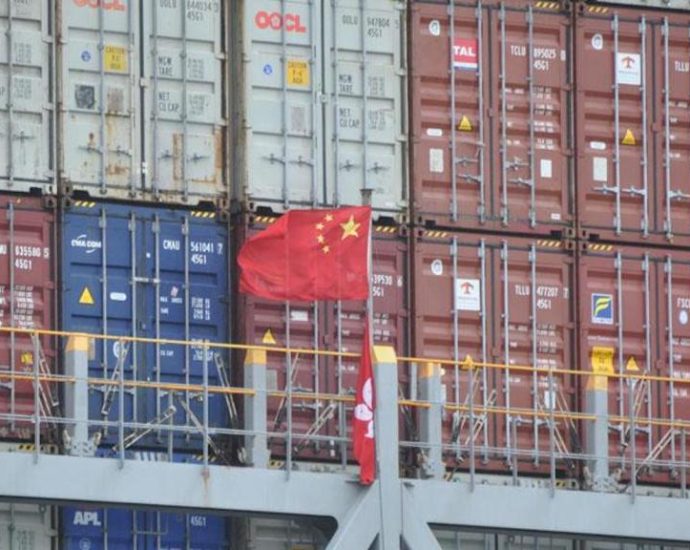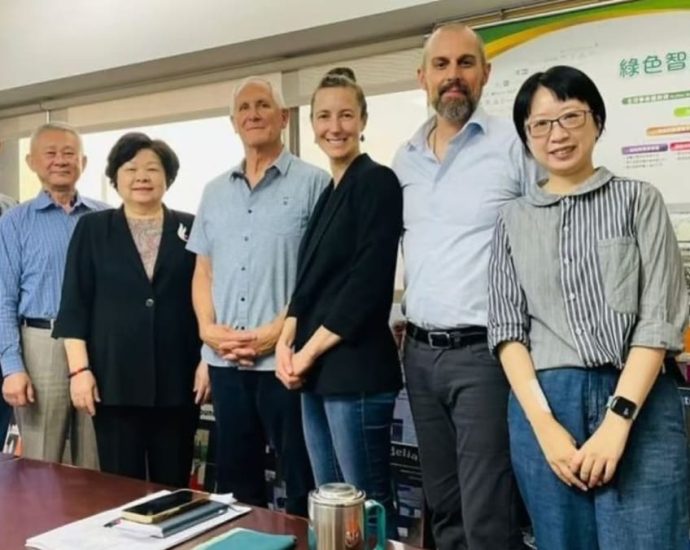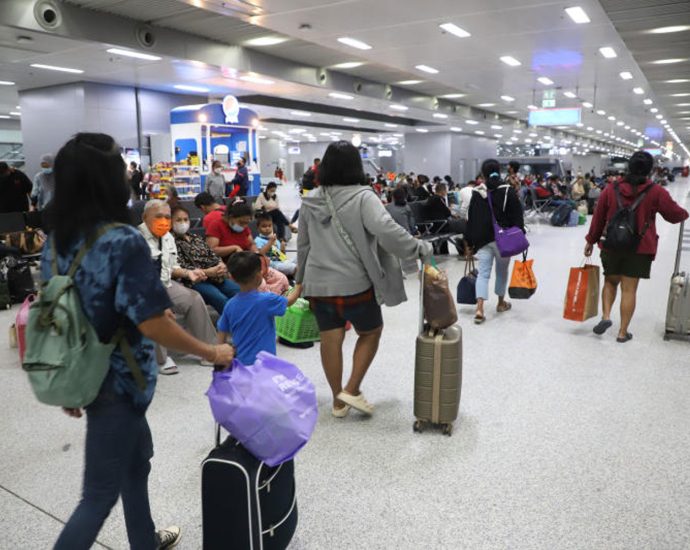The fatal contradictions of China-bashing

The contradictions of China-bashing in the United States begin with how often it is flat-out untrue.
The Wall Street Journal reports that the “Chinese spy” balloon that President Joe Biden shot down with immense patriotic fanfare in February did not in fact transmit pictures or anything else to China.
White House economists have been trying to excuse persistent US inflation saying it is a global problem and inflation is worse elsewhere in the world. China’s inflation rate is 0.7% year on year.
Financial media outlets stress how China’s GDP growth rate is lower than it used to be. China now estimates that its 2023 GDP growth will be 5-5.5%. Estimates for the US GDP growth rate in 2023, meanwhile, vacillate around 1-2%.
China-bashing has intensified into denial and self-delusion – it is akin to pretending that the United States did not lose wars in Vietnam, Afghanistan, Iraq and more.
The BRICS coalition (China and its allies) now has a significantly larger global economic footprint (higher total GDP) than the Group of Seven (the United States and its allies).
China is outgrowing the rest of the world in research and development expenditures.
The American empire (like its foundation, American capitalism) is not the dominating global force it once was right after World War II. The empire and the economy have shrunk in size, power and influence considerably since then. And they continue to do so.
Putting that genie back into the bottle is a battle against history that the United States is not likely to win.
The Russia delusion
Denial and self-delusion about the changing world economy have led to major strategic mistakes. US leaders predicted before and shortly after February 2022, when the Ukraine war began, for example, that Russia’s economy would crash from the effects of the “greatest of all sanctions,” led by the United States. Some US leaders still believe that the crash will take place (publicly, if not privately) despite there being no such indication.
Such predictions badly miscalculated the economic strength and potential of Russia’s allies in the BRICS. Led by China and India, the BRICS nations responded to Russia’s need for buyers of its oil and gas.
The United States made its European allies cut off purchasing Russian oil and gas as part of the sanctions war against the Kremlin over Ukraine. However, US pressure tactics used on China, India, and many other nations (inside and outside BRICS) likewise to stop buying Russian exports failed. They not only purchased oil and gas from Russia but then also re-exported some of it to European nations.
World power configurations had followed the changes in the world economy at the expense of the US position.
The military delusion
War games with allies, threats from US officials, and US warships off China’s coast may delude some to imagine that these moves intimidate China. The reality is that the military disparity between China and the United States is smaller now than it has ever been in modern China’s history.
China’s military alliances are the strongest they have ever been. Intimidation that did not work from the time of the Korean War and since then will certainly not be effective now.
Former president Donald Trump’s tariff and trade wars were meang, US officials said, to persuade China to change its “authoritarian” economic system. If so, that aim was not achieved. The United States simply lacks the power to force the matter.
American polls suggest that media outlets have been successful in a) portraying China’s advances economically and technologically as a threat, and b) using that threat to lobby against regulations of US high-tech industries.
The tech delusion
Of course, business opposition to government regulation predates China’s emergence. However, encouraging hostility toward China provides convenient additional cover for all sorts of business interests.
China’s technological challenge flows from and depends on a massive educational effort based on training far more STEM (science, technology, engineering and mathematics) studengs than the United States does. Yet US business does not support paying taxes to fund education equivalently.
The reporting by the media on this issue rarely covers that obvious contradiction and politicians mostly avoid it as dangerous to their electoral prospects.
Scapegoating China joins with scapegoating immigrants, BIPOCs (black and Indigenous people of color), and many of the other usual targets.
The broader decline of the US empire and capitalist economic system confronts the nation with the stark question: Whose standard of living will bear the burden of the impact of this decline? The answer to that question has been crystal clear: The US government will pursue austerity policies (cut vital public services) and will allow price inflation and then rising interest rates that reduce living standards and jobs.
Coming on top of 2020’s combined economic crash and Covid-19 pandemic, the middle- and-lower-income majority have so far borne most of the cost of the United States’ decline. That has been the pattern followed by declining empires throughout human history: Those who control wealth and power are best positioned to offload the costs of decline on to the general population.
The real sufferings of that population cause vulnerability to the political agendas of demagogues. They offer scapegoats to offset popular upset, bitterness and anger.
Leading capitalists and the politicians they own welcome or tolerate scapegoating as a distraction from those leaders’ responsibilities for mass suffering. Demagogic leaders scapegoat old and new targets: immigrants, BIPOCs, women, socialists, liberals, minorities of various kinds, and foreign threats.
The scapegoating usually does little more than hurt its intended victims. Its failure to solve any real problem keeps that problem alive and available for demagogues to exploit at a later stage (at least until scapegoating’s victims resist enough to end it).
The contradictions of scapegoating include the dangerous risk that it overflows its original purposes and causes capitalism more problems than it relieves.
If anti-immigrant agitation actually slows or stops immigration (as has happened recently in the United States), domestic labor shortages may appear or worsen, which may drive up wages, and thereby hurt profits.
If racism similarly leads to disruptive civil disturbances (as has happened recently in France), profits may be depressed.
If China-bashing leads the United States and Beijing to move further against US businesses investing in and trading with China, that could prove very costly to the US economy. That this may happen now is a dangerous consequence of China-bashing.
Working together (briefly)
Because they believed it would be in the US interest, then-president Richard Nixon resumed diplomatic and other relations with Beijing during his 1972 trip to the country. Chinese chairman Mao Zedong, premier Zhou Enlai, and Nixon started a period of economic growth, trade, investment and prosperity for both China and the United States.
The success of that period prompted China to seek to continue it. That same success prompted the United States in recent years to change its attitude and policies. More accurately, that success prompted US political leaders like Trump and Biden to now perceive China as the enemy whose economic development represents a threat. They demonize the Beijing leadership accordingly.
The majority of US mega-corporations disagree. They profited mightily from their access to the Chinese labor force and the rapidly growing Chinese market since the 1980s. That was a large part of what they meant when they celebrated “neoliberal globalization.” A significant part of the US business community, however, wants continued access to China.
The fight inside the United States now pits major parts of the US business community against Biden and his equally “neoconservative” foreign-policy advisers. The outcome of that fight depends on domestic economic conditions, the presidential election campaign, and the political fallout of the Ukraine war as well the ongoing twists and turns of the China-US relations.
The outcome also depends on how the masses of Chinese and US people understand and intervene in relations between these two countries. Will they see through the contradictions of China-bashing to prevent war, seek mutual accommodation, and thereby rebuild a new version of the joint prosperity that existed before Trump and Biden?
This article was produced by Economy for All, a project of the Independent Media Institute, which provided it to Asia Times.
Russian man dies after falling from pagoda in Phuket

PHUKET: A Russian man died after falling from the roof of a pagoda in Muang district of this island province on Friday night.
Police received a report that the tourist, whose name was not identified, climbed up to the roof of the pagoda at Wat Chaithararam, or better known as Wat Chalong, in tambon Chalong at around 5.30pm.
Police and rescue workers rushed to the scene to help persuade him to climb down, as they were concerned that he might jump and take his own life. By 7.55pm, he still refused to come down.
Phuket Governor Narong Woonciew, along with local officials, rescue teams, medics and concerned agencies, arrived at the temple, and safety cushions were prepared.

The Russian man is seen standing on the roof of a pagoda at Wat Chalong in Phuket on Friday evening. Police and officials tried in vain to persuade him to climb down. (Photo: Achadthaya Chuenniran)
After negotiations failed, rescue staff charged towards the tourist at around 8.27pm. During the struggle, the man fell onto the safety cushions but sustained injuries. The medics immediately transported him to Vachira Phuket Hospital.
Hospital officials reported that his heart had stopped beating, and doctors on duty were making efforts to resuscitate him.
Local news media reported on Saturday morning that the Russian man had died.

Wat Chaithararam, or Wat Chalong, is a historical landmark and Buddhist temple in Phuket’s Chalong Bay. (File photo: Achadthaya Chuenniran)
US-China relations need a new set of guardrails
In June 2023, four months after a wayward surveillance balloon blew his impending visit off course, US Secretary of State Antony Blinken visited Beijing to set about erecting the “guardrails” US President Joe Biden and Chinese President Xi Jinping envisaged in Bali in November 2022.
He was followed in early July by Treasury Secretary Janet Yellen. The United States and China may be close to stabilizing their rocky relationship — an opportunity they must not pass up.
The Biden administration’s strategy on China has been to invest in domestic competitiveness, align efforts with a network of allies and partners and, harnessing these assets, compete with China. The administration has also sought to isolate China via the Summit for Democracy, Quad and Indo-Pacific Economic Framework and through bodies such as the G7.
Having incentivized or leaned on allies to chip away at their relationships with China, Washington now seeks to establish a “floor” under its own working relations with Beijing.
For China, forging the “least worst” relationship with the United States retains value from a geopolitical and developmental standpoint, given ties could yet hurtle to the point of total breakdown.
There are no illusions, though, that bilateral trade and technology frictions are a mere economic matter. They are intended to suppress China’s development and rise – eliciting calls for “self-reliance.”

US-China guardrails must be cognizant of these eroding political foundations. To be durable, they must abide by certain broad understandings.
The “pressure valve of dialogue” must become the “first and most fundamental” guardrail on the relationship. While beneficial engagement cannot coexist with coercion, dialogue must not be construed as leverage or a favor to be bestowed.
Dialogue must be based on mutual respect. Both sides are at liberty to introduce sanctions for national security or public interest reasons. Akin to the European Parliament’s suspension of ratification of the European Union-China investment agreement in May 2021 following Beijing sanctioning some EU actors, neither side should harbor the illusion that business-as-usual measures or open channels of communication can be maintained with sanctioned parties.
Next, the practice of self-restraint rather than the pursuit of behavior modification of the other must become standard order. Both Washington and Beijing must rise above their visions of ideology and sculpt a durable consensus. This includes the formation of civilian-led crisis management channels, rather than solely relying on the unsatisfactory military-to-military mechanisms.
Just because the Shanghai Communique-inaugurated era of strategic cooperation has died does not axiomatically mean the United States and China are fated to succumb to conflict. An intermediate equilibrium is realisable but its authorship will require exceptional diplomatic skill.
Third, US-China relations must be framed with the view to reassuring the other and narrowing differences without losing sight of the underlying challenges. In Bali, Xi had proffered “three noes.” China does not seek to change the existing international order, does not interfere in the United States’ internal affairs and has no intention of displacing the United States.
Biden tendered “five noes.” The United States does not seek a new Cold War. It does not seek to change China’s system. The revitalization of its alliances is not directed at China. It does not support Taiwanese independence. And it does not seek conflict with China.
These assurances provide a ballast to steady the ship of US-China relations. It serves little purpose for either side to dwell on the underlying intentions of its counterpart’s assurances. Both sides should accept them in good faith and aspire to memorialize them in a joint communique if the opportunity arises.
Fourth, both parties must endeavor to abide by the inviolability of each other’s territorial interests. Washington vowed in the Shanghai Communique that it would “not challenge [the Chinese] position” that Taiwan is a part of the People’s Republic of China — even as it “acknowledge[d]” but did not “recognize” Taiwan to be part of China.
Today, the United States relentlessly challenges that proposition, including stripping out the phrase “Taiwan is a part of China” from the State Department’s fact sheet on Taiwan relations. The challenge must stop and Washington must credibly signal that its “one-China policy” is not being hollowed out.

For its part, Beijing must credibly signal that peaceful reunification remains on the table and that there is no specific timeline for reunification. Episodes like the balloon incident must not be repeated either. But until China’s human rights record improves and the state’s intervention in the economy is reduced, the profound perceptual gap between the two sides will not markedly narrow.
Finally, both sides must anchor their relationship in settled international law. China must fully comply with the South China Sea arbitral tribunal’s award. The ruling by a Law of the Sea Annex VII-constituted tribunal that the United States’ sprawling Diego Garcia military base in the Western Indian Ocean is effectively housed on illegally occupied Mauritian territory (under British colonial administration) is also binding.
Successor arrangements must be arrived at with due regard for Mauritius’ sovereignty. World Trade Organization (WTO) rulings must be honored too. The international trading order is, after all, part of the “rules-based order.”
Prospects for sustained progress in US-China relations may be modest in the near term. Depending on the result of the 2024 US presidential election, an opportunity to craft a more durable strategic framework might open up. To seize that opportunity, much hinges on getting the guardrails right at the present.
Sourabh Gupta is a Senior Fellow at the Institute for China-America Studies in Washington, DC.
This article was originally published by East Asia Forum and is republished under a Creative Commons license.
US-China cooperation in climate finance ‘critical’: Yellen
BEIJING: It is “critical” for Washington and Beijing to keep working together on climate finance, US Treasury Secretary Janet Yellen said Saturday (Jul 7), urging deeper cooperation in addressing the “existential threat” of global warming. Yellen is on a four-day trip to Beijing, as the United States seeks to coolContinue Reading
US-China decoupling headed in a dangerous direction
The US and Chinese economies are closely interconnected, but their ties are eroding. Despite record levels of US-China bilateral trade in 2022, the trading relationship is becoming less interdependent. Rising tensions between Washington and Beijing are driving US and Chinese investors away from each market.
Perhaps the most consequential aspect of US-China decoupling is in technology. Security competition between the United States and China is increasingly embedded in approaches to domestic industrial and technological development. This tech war will hurt both economies and have profound global implications.
Bilateral trade between the United States and China continues to expand despite the trade-war tariffs and escalating tech restrictions that the United States has imposed on China. But bilateral trade expansion is slowing and is growing at only one-fifth the pace of the overall US trade expansion.
The share of US imports coming from China has declined, while China has shifted some imports of foreign goods away from the United States. The composition of US-China bilateral trade has also shifted away from goods with the highest tariffs.
Data on bilateral trade alone does not show the full picture of US-China commercial ties. Since the tariff war began, China’s direct investment in Southeast Asia has skyrocketed — reaching US$128 billion in 2020. US imports from Southeast Asia are also expanding rapidly.
But China’s share of the imported content in Vietnam’s exports nearly doubled from 2017 to 2021. Similarly, Chinese firms elsewhere in Southeast Asia source a large share of the parts and components in their US exports from China. The Chinese content of US imports from Southeast Asia is likely on the rise, offsetting the slowdown in direct US imports from China.

Cumulative direct investment in China by US firms reached $124 billion in 2020, according to data from the Office of the United States Trade Representative. But the 25th annual China Business Survey by the American Chamber of Commerce in China shows that a declining share of US companies see China as an investment priority because of rising tensions, a lack of regulatory consistency in China and rising costs of labor.
The survey also shows that though most US firms operating in China plan to stay, a rising share are considering shifting supply chains out of China — including Apple and Google.
Prospects of US investment in China are clouded by potential US restrictions on outbound investment to China. The Biden administration is concerned that US investors may be helping to advance Chinese technology in critical sectors and is developing a mechanism to constrain the flow of US investment into China.
But because US firms constitute a relatively small portion of total foreign direct investment, such a screening scheme will only be effective if other states are involved. The difficulties of convincing others to develop similar programs may be causing the delay in the launch of a US outbound investment screening scheme.
Private and state-owned Chinese firms are facing greater scrutiny in the United States. The Committee on Foreign Investment in the United States has seen its investigations involving Chinese investors surge since 2021.
Among all jurisdictions, investors from China face the most scrutiny. The most recent high-profile case involves TikTok, whose CEO was recently grilled by the US Congress. The company now faces the risk of being banned in the United States unless it splits from its Chinese parent company ByteDance.
US-China decoupling in technology is undoubtedly intensifying. Beginning with Trump’s restrictions on US exports to Huawei in 2018, the United States has been stepping up its tech restrictions on China in the past five years. By the end of 2022 about 400 Chinese persons on the Specially Designated Nationals and Blocked Persons list were prohibited from engaging in any transactions involving US persons.
In March 2023, 665 Chinese companies on the US Entity List were subject to restrictions on the flows of certain technology and goods from the United States. China responded with its own Unreliable Entity List in September 2020. So far only two US aerospace and defense companies are listed and prohibited from trading with or investing in China.
US-China technological decoupling escalated in September 2022 when US National Security Advisor Jake Sullivan announced a profound shift in US economic policy on China. Rather than designing export restrictions to keep China’s critical technologies a generation behind that of the United States, the US objective is now to freeze China’s current level of technological development.
As the US tech frontier continues to expand, the gap between the two countries would widen, causing China to fall further behind.
In October 2022, the Biden administration announced export restrictions on certain equipment and services to Chinese semiconductor companies, aiming at slowing China’s ability to produce advanced chips – a US national security concern. Japan and the Netherlands have joined the US effort in restricting exports of semiconductor manufacturing equipment to China.
Given the stated US goal in maintaining “as large of a lead as possible” in semiconductors, quantum computing, artificial intelligence and other critical sectors, it is not surprising that China’s President Xi Jinping has stated that the United States attempts to contain, encircle and suppress China.

China is now pouring hundreds of billions of dollars into cutting-edge technologies to achieve self-sufficiency. The West’s economic sanctions following Russia’s aggression against Ukraine worry Chinese leaders who fear similar sanctions could be applied to China if it pursues reunification with Taiwan.
Technological decoupling raises serious concerns about global growth in the short and long term. A 2021 IMF study identifies three direct channels where technological decoupling can affect global growth — reduced global trade flows, misallocation of resources and less cross-border knowledge diffusion.
Together with trade fragmentation and “friend-shoring”, technological decoupling can lead to significant economic losses globally. The drive for self-sufficiency is costly and success is not guaranteed.
Reining in techno-nationalism is in the United States and China’s interests, but the political reality in both capitals is making rational policy formulation extremely difficult.
Nicholas R Lardy is Non-resident Senior Fellow at the Peterson Institute for International Economics. Tianlei Huang is Research Fellow and China Program Coordinator at the Peterson Institute for International Economics.
This article was originally published by East Asia Forum and is republished under a Creative Commons license.
US firms snub ‘de-risking’ to give China another shot â but theyâre finding a new obstacle
“It could not have been a warmer reception than what we received,” said American businessman Jeff Bowman after spending a week in China last month. Bowman is the CEO of the US materials science company Cocona, with his unique sweat-drying Masterbatch additive for yarn garnering significant interest in the China-basedContinue Reading
Central terminal courts single bidder

Only one company has bid for the commercial development of Krung Thep Aphiwat Central Terminal despite three firms having purchased invitations to tender, the State Railway of Thailand (SRT) announced on Friday.
Ekkarat Sriarayanpong, head of the SRT governor’s office, said the SRT had four projects that recently opened for bidding. First was the commercial use project the SRT expects to have a private company develop, covering 47,675 square metres at the central terminal.
Three companies procured invitations to tender: Central Pattana, King Power Suvarnabhumi and Prem Group Engineering. However, only Prem Group Engineering ended up bidding, Mr Ekkarat said.
The second project is managing a 2,303m² advertising space at the central grand station. Plan B Media and King Power International purchased invitations to tender, but neither has bid for the project, he added.
The third project is to develop a 3,759m² space at 12 stations on the Red Line electric commuter train service, which connects the central station to the Rangsit area in Pathum Thani. No one purchased an invitation to bid, Mr Ekkarat said.
The fourth project is to manage 2,080m² of advertising space at the 12 Red Line stations. Plan B Media and King Power International also bought invitations to tender but elected not to proceed.
Mr Ekkarat said after the deadlines to submit the bidding proposals for all four projects ended in the middle of this week, only one company — Prem Group Engineering — bid for the first project.
The SRT will review the company qualifications and will announce the result next Thursday, he said.
The SRT will then check its technical proposal on Aug 15 and open the bid proposal on Aug 16 the following day.
As for the remaining three projects for which the SRT has yet to find bidders, its selection committee will conclude a report for the next board meeting to find solutions, he said.

Krung Thep Aphiwat Central Terminal, formerly known as Bang Sue Grand Station, in Chatuchak district, Bangkok. (Photo: Nutthawat Wichieanbut)
Three railway workers arrested over India’s deadly train crash
Relatives spent days combing through possessions and looking at post-mortem pictures of those killed in the crash, to identify their loved ones. At least 850 others were injured in the collision. Days after the accident, India’s railway minister Ashwini Vaishnaw said the crash was the result of an issue withContinue Reading
Sri Lankan mahout honoured by royals

Their Majesties the King and Queen presented a gift to a Sri Lankan mahout who took care of the ailing Thai elephant Sak Surin, now in 30-day quarantine in Lampang province, after being flown from Sri Lanka on July 2.
Air Marshal Pakdee Saengchuto, deputy private secretary to the King, represented the monarch on Thursday to provide the gift to Don Upul Jayarathna Denelpitiyage, the mahout from Dehiwala Zoo in Sri Lanka, according to the Ministry of Natural Resources and Environment’s Facebook page on Friday.
The ceremony was held at the ministry, with permanent secretary Jatuporn Buruspat and Mr Denelpitiyage attending.
Mr Denelpitiyage accompanied an official Thai team to fly from Sri Lanka to Thailand to help care for Sak Surin, who is now being looked after at the Thai Elephant Conservation Centre. Mr Denelpitiyage returned to Sri Lanka on Friday.
The ministry spent about 19 million baht caring for 30-year-old Sak Surin and bringing him back to Thailand for medical treatment.
He is one of three elephants Thailand sent to Sri Lanka to strengthen diplomatic relations following a Sri Lankan request for the Thai government to send elephants to carry the Lord Buddha’s relics in special religious ceremonies.
Meanwhile, the Thai ambassador to Sri Lanka on Friday said Pratu Pha, another 49-year-old male elephant, has been living under normal conditions in the island nation, adding that there are no plans to bring him back to Thailand.
Ambassador Poj Harnpol said he visited Pratu Pha at Wat Sri Dala Maligawa (Temple of the Tooth Relic) in Kandy City where the elephant is kept, on Thursday. The visit was made at the invitation of Pradeep Nilanga Dela Nilame, the temple caretaker.
Mr Poj said Pratu Pha lives in an open courtyard — with a concrete and soil surface — marked by ropes to indicate boundaries.
The elephant’s front legs are chained to two big trees, while one of the hind legs is lightly chained, allowing it to move and stand naturally.
Pratu Pha can consume food such as leaves from kithul trees, grass and sugar cane as normal, said the ambassador.
During his 30 minutes of observation, the elephant did not display any signs of aggression, and a mahout could feed the animal from a distance.
Mr Poj emphasised the importance of improving the landscape and ensuring adequate water sources and water tanks for the elephant’s well-being.
“Although the general condition is satisfactory to some extent, Pratu Pha’s living conditions could still be improved,” the envoy said.
“We acknowledge the efforts being made by the temple, and the situation cannot be changed in a day. We will work towards better care,” he said.
In an interview with Sri Lankan media, Mr Poj said Thailand has no plans to return Pratu Pha, who is also known as Thai Raja.
Pratu Pha was gifted to Sri Lanka 37 years ago, while Sak Surin and another male jumbo, Sri Narong, were sent there 22 years ago as goodwill gifts.
Why Lunoji founder Adrian Lim took a 75% pay cut to design pet products

From a one-man operation, Lunoji has now expanded to a team of four, including two designers and one marketing person. His mother, who is currently clear of cancer, also helps part-time, making treats and blends, and fulfilling orders.
“The biggest issue we had, and still have, is funding,” said Lim, who currently pays himself a modest salary of S$2,500 a month to channel more money into the business.
“When I walk past places like Tori-Q where the salary of full-time staff starts from around S$2,800, I sometimes question myself. Am I stupid for doing this? Because I could be earning close to S$10,000 with my previous job. There is a lot of sacrifice,” he admitted.
But he has no regrets embarking on this journey, which has also helped in his recovery from depression – Lim was able to go off medication last year.
“To say, I thought of an idea and now we’ve got thousands of them all around the world is priceless.
“With this business, I can really see the impact of what I do on people’s and animals’ lives. One of the little things I like to do is just lie on my bed and watch the Instagram stories and posts that people tagged us on. My bank account is empty but my heart is full,” he said.

